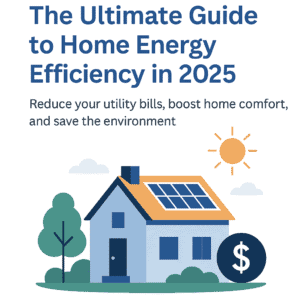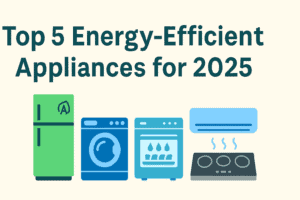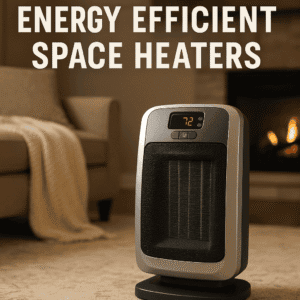Top 10 Winter Energy Saving Tips 2025
As winter arrives and temperatures drop, households across the globe face the challenge of balancing comfort with rising energy costs. In 2025, savvy homeowners turn to proven winter energy saving tips to reduce heating bills, optimize shed warmth, and minimize environmental impact. In this comprehensive guide, we unveil the top 10 strategies—from small behavior changes to impactful retrofits—that can cut your winter energy use by 20–50%. Whether you’re upgrading insulation, sealing drafts, or integrating smart gadgets, these tips are designed to help you stay warm while paying less. By blending modern technology with timeless efficiency principles, you’ll be well-prepared for chilly seasons ahead. Use the links to dive deeper or create your own winter toolkit.
1. Maximize Thermostat Management
Controlling your heating costs starts with your thermostat—one of the most effective winter energy saving tips.
- Smart thermostat programming: Lower to 68 °F during the day and 60–62 °F at night or when away. This simple 7–10°F setback can save 10–20% annually.
- Smart thermostat benefits: Devices like Nest and Ecobee adapt schedules, use geofencing, and provide energy reports—helping save even more.
- Zoning strategies: Use smart thermostatic radiator valves or zoned HVAC with smart thermostats to control temperature by zone for extra efficiency.
- Avoid overcooling or overheating: Consistent temperatures mean less recovery energy—opt for slow drops instead of drastic swings.
- Temperature awareness: Wear a layer before cranking the heat—behavioral habits reduce needed heating demand.
Thermostat control is among the easiest yet most impactful winter energy saving tips you can implement today.
2. Seal Air Leaks and Insulate Envelopes
Drafts and poor insulation can negate all other savings. These winter energy saving tips focus on tightening your building envelope.
- Draft sealing: Use caulking, weatherstripping, or foam sealant around windows, doors, baseboards, and attic hatches. Caulk costs just a few dollars but saves ~$150/yr.
- Insulate smartly: Add insulation to attic floors (R-49–60), walls (R-13–21), and basements. Start with air sealing before adding insulation for best results.
- Fireplace damper: Close dampers when not in use. Add a “chimney sheep” wool draft stopper for ~$27 to block heat loss.
- Window treatments: Use heavy drapes or thermal blinds, and add clear plastic insulation film on drafty windows.
- Pipe wrap: Insulate hot-water pipes near the heater—saving heat before it travels through cold spaces.
Proper sealing and insulation are core winter energy saving tips, protecting your entire heating investment.
3. Maintain Heating Systems
An efficient furnace or heat pump runs clean and well-tuned. These winter energy saving tips will help keep it that way.
- Annual tune-ups: Clean or replace filters regularly and schedule professional HVAC inspections.
- Clean vents: Make sure air registers and returns are clear—not blocked by furniture or curtains.
- Ceiling fan reversal: Set fans to turn clockwise on low to push warm air downward .
- Monitor system performance: Rising bills may signal issues—use energy monitors to detect anomalies.
- Simple pressure helpers: Use radiator foil behind panel heaters to reduce wall heat loss.
Routine maintenance ranks among the most effective winter energy saving tips you can follow.
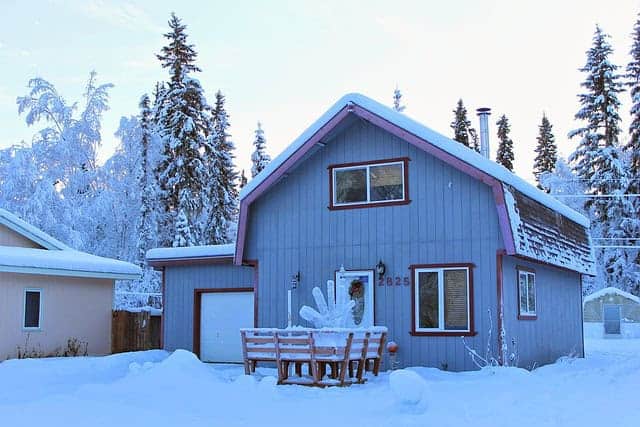
4. Use Space Heaters Wisely
Space heaters can be more efficient than heating an entire home—if used smartly.
- Target occupied zones: Heat small, well-insulated rooms instead of the whole house.
- Safety habits: Permit a 3-foot clearance around space heaters and plug directly into wall outlets.
- Choose efficient tech: Ceramic or oil-filled heaters work best. Avoid outdated radiant models.
- Smart usage: Turn off when leaving or sleeping to avoid wasted energy.
- Supplemental comfort: Wear warm clothes, use heated blankets, and layer blankets rather than crank up central heat.
Used judiciously, space heaters are a highly effective winter energy saving tip.
5. Implement Passive Solar Gains
Let the sun heat your home for free with these clever strategies:
- Open south-facing windows during the day for passive solar gain.
- Close curtains at night to reduce heat loss.
- Use thermal mass (tiles, brick floors) to soak up daytime warmth for evening release.
- Tree placement: Deciduous shade trees preserve summer shade and let winter sun pass through.
- Solar DIY additions: Add low-E window film for under $20 to boost winter insulation.
Harnessing the sun is one of the most passive yet effective winter energy saving tips.
6. Insulate and Wrap Your Water Heater
Water heating can represent 15–20% of winter energy use. These winter energy saving tips cut that waste.
- Lower temperature: Set water heaters to 120°F to save and prevent scalding.
- Tank insulation: Install a simple water heater blanket—costs $25, pays for itself in months.
- Pipe insulation: Wrap the first 3–6 feet of hot and cold pipes to reduce conduction loss.
- Consider heat-pump or tankless heaters: Higher upfront cost, but 2–3x efficiency.
- Habits: Use low-flow shower heads and wash full loads in cold water.
These strategies are essential winter energy saving tips for reducing hot-water energy.
7. Update Lighting to LEDs
Lighting may not heat your space, but every watt counts:
- Switch to LED bulbs: Use 75–80% less energy than incandescent, and lasts far longer.
- Install dimmers and timers to reduce usage.
- Take holiday lighting outside; choose LED strands to cover festive needs without high energy costs.
- Timed or motion lighting in hallways and porches gives safety without waste.
- Use natural daylight near windows during day.
LED upgrades are small in effort but impactful among winter energy saving tips.
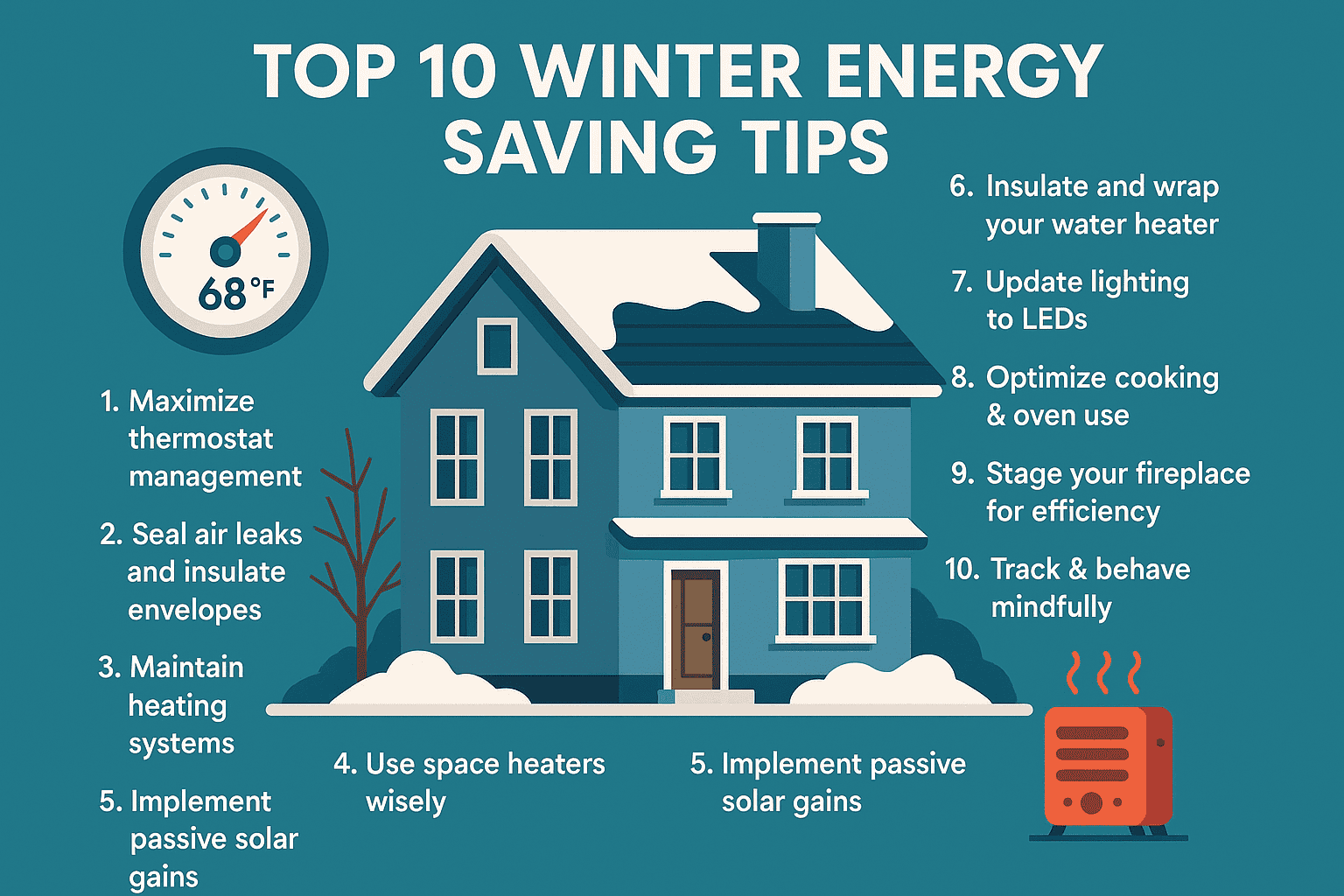
8. Optimize Cooking & Oven Use
Your oven and stove create heat—use them to your advantage:
- Reuse residual oven heat: Leave the door slightly open after baking to warm adjacent rooms.
- Cook lower and cover pots to save on heat loss.
- Use microwaves or pressure cookers—they use 80% less energy than ovens for many meals.
- Maintain induction stovetops to minimize wasted heat.
- Use lids & batch cooking to reduce stove-on time—core practices in the best winter energy saving tips.
Smart cooking habits help heat your home without extra energy consumption.
9. Stage Your Fireplace for Efficiency
If you use a fireplace, maximize efficiency with:
- Only burn fires when needed; close dampers loudly with blowers or glass doors.
- Install bottom flue blockers or a “chimney sheep” to reduce overnight drafts.
- Place fireplace grilles and fans to recirculate warmth into the room.
- Seal hearth gaps and install tempered glass doors for safety and heat retention.
- Alternative heat sources: Consider gas or electric inserts if wood fireplaces prove inefficient.
These are specialized—but powerful—winter energy saving tips for hearth users.
10. Track & Behave Mindfully
Long-lasting savings come from tracking and changing habits:
- Install home energy monitors (Sense, Emporia) to identify peaks and waste.
- Observe micro-moments when lights or heating turn on unintentionally .
- Schedule appliances for off-peak energy use (dishwashers, washing machines).
- Practice habits like turning off unused devices, wearing layers, and using heated throws.
- Review usage monthly, set realistic goals, and align with utility incentives.
Mindful behavior, along with data, turns these winter energy saving tips into long-run success.
Internal Linking
- Home Energy Audit: How to Perform a Home Energy Audit
- Pillar Efficiency Guide: Ultimate Guide to Home Energy Efficiency in 2025
- Smart Thermostat Tips: How Smart Thermostats Save You Money
- Appliance Efficiency: Top 5 Energy-Efficient Appliances for 2025
FAQs
What temperature should I set my thermostat in winter?
Experts recommend setting your thermostat around 68 °F during the day, and reducing it to 60–62 °F at night or when you’re away for best winter energy saving tips :contentReference[oaicite:102]{index=102}.
Do smart thermostats help save money in winter?
Yes—smart thermostats automatically adjust heating schedules, use geo-fencing, and provide usage reports that help reduce heating bills by up to 20%.
Is sealing drafts really effective?
Absolutely—Caulking and weatherstripping can save hundreds annually while keeping indoor temperatures more consistent. Adding insulation multiplies these effects.
Are space heaters cost-effective?
Used correctly—targeted heating, modern efficient models, and safety measures—space heaters can reduce overall heating costs.
Final Summary
These Top 10 Winter Energy Saving Tips for 2025 blend low-cost DIY steps, behavior changes, system maintenance, and smart strategies to cut heating costs by 20–50%. Begin with thermostat adjustment and draft elimination, enhance comfort with insulation and system tune-ups, and push savings further using smart gadgets and data monitoring. Combined, these tips provide a multi-layered approach: sealing, heating, cooking, lighting, self-awareness—all well-structured and ready-to-implement.


